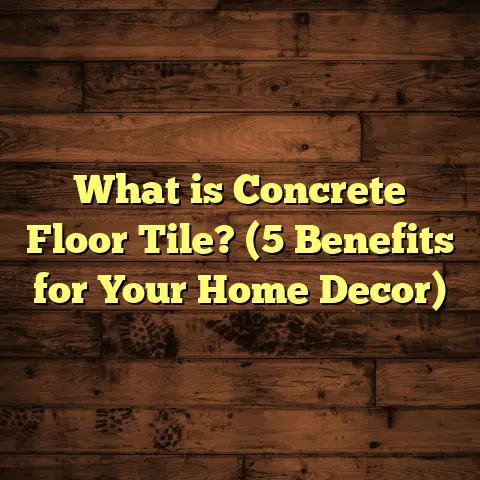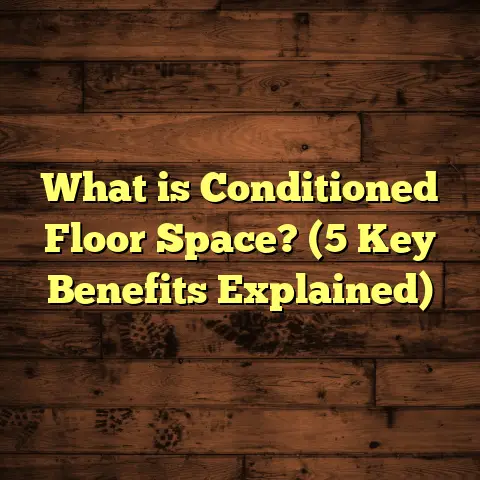What is Cupped Flooring? (5 Causes & Solutions Explained)
Warmth in a home isn’t just about the thermostat setting. It’s
also about how comfortable and inviting the space feels underfoot.
I’ve always been a fan of wood floors for that very reason.
There’s something about walking barefoot on warm wood that makes
a house feel like a home. But sometimes, even the warmest, most
beautiful floors can show signs of trouble, and one of the most
common—and frustrating—issues is called cupped flooring.
If you’ve ever noticed your wood floor looking wavy or the edges of
the planks curling up higher than the center, that’s cupping. It’s
more than just a cosmetic problem; it can affect how safe and stable
your floors feel. I’ve dealt with this issue many times over the years,
and I want to share everything I’ve learned about why it happens and
how to fix it so your floors stay warm, flat, and beautiful.
What is Cupped Flooring?
Cupped flooring happens when individual wood planks curl upward
at the edges while the center remains lower, creating a concave or
“cup-like” shape. Instead of lying flat, the floorboards look as if
they’re slightly scooped out from above.
This condition usually affects hardwood or engineered wood floors but can
occur with any wood flooring exposed to moisture or improper installation.
Why does this happen?
Wood is hygroscopic—it naturally absorbs and releases moisture from the air.
When the moisture content on the bottom side of a plank is higher than on the top,
the wood fibers expand unevenly. Since wood expands across its width more than its length,
the edges swell more than the center, causing them to lift.
Imagine a wooden board soaked on one side but dry on the other—it will warp,
curling towards the dry side. This is exactly what happens with cupping floors.
How serious is cupping?
While mild cupping might just look like an uneven floor, more severe cases can cause:
- Tripping hazards due to raised edges
- Increased wear and damage to floorboards where edges rub or catch
- Potential gaps forming between boards as they shift
- A generally unstable or bouncy floor feel
If ignored, cupping can lead to costly repairs or even full floor replacement.
How can you tell if your floor is cupped?
Here’s a simple test I’ve done many times: press your hand down flat on a plank and feel for any gaps near the edges. Or visually scan from different angles—cupped boards catch light differently because of their shape.
My Story With Cupped Floors
Years ago, I was called to a home where the owners were frustrated after spending thousands on installing a new oak floor. Just six months later, noticeable waves had appeared across several rooms. The edges of many planks were raised, making walking uncomfortable.
After inspecting moisture levels beneath the subfloor and inside the wood boards themselves, I discovered moisture was coming up through an unsealed concrete slab basement floor below. The installer hadn’t used a vapor barrier—a common mistake in humid climates.
The homeowner was upset but relieved to understand what caused the issue. We fixed the moisture source, installed a proper vapor barrier, and replaced damaged planks with better acclimated wood. Their floors have stayed flat ever since.
That experience made me realize how often moisture-related problems are misunderstood and mishandled in flooring projects. So let’s break down the main causes one by one so you can avoid that headache.
Cause #1: Excess Moisture Below the Floor
One of the biggest culprits for cupped flooring is moisture trapped beneath the floorboards—especially in basements or ground-level rooms over concrete slabs or crawl spaces.
If water vapor rises through porous concrete or damp soil, it can soak into the underside of wood planks unevenly and cause them to swell at the edges. This imbalance leads to cupping.
Why does this happen under concrete slabs?
Concrete is porous and can absorb groundwater or moisture from rain seepage. Without a proper vapor barrier (usually a thick plastic sheet), moisture slowly rises through concrete and saturates any wood flooring installed above it.
Even if your floor looks dry on top, moisture underneath can cause serious problems later on. I’ve seen homes more than 10 years old develop cupping from this silent moisture source that wasn’t addressed at installation.
Crawl spaces and ventilation issues
Homes built over crawl spaces without adequate ventilation or vapor barriers face similar risks. Moisture accumulates under the floor and seeps into wood decking or subflooring. Without airflow to dry it out, humidity rises and damages wood flooring above.
My experience diagnosing this cause
I use moisture meters that read both surface and internal moisture content to detect hidden problems. In one case study, I found moisture levels beneath a kitchen floor were 40% higher than recommended levels while surface readings seemed normal—explaining why only some boards were cupping while others looked fine.
How to prevent excess moisture under floors
- Install a vapor barrier (6-mil polyethylene plastic) under all wood floors installed over concrete slabs or crawl spaces before laying plywood subfloors or hardwood planks.
- Make sure crawl spaces have vents or mechanical ventilation systems to encourage airflow and reduce humidity buildup.
- Use sump pumps or drainage solutions if groundwater intrusion is an issue in your area.
- Test moisture levels regularly during installation with reliable meters—don’t guess!
Cause #2: High Indoor Humidity Levels
Wood naturally pulls moisture from humid air and releases it when air dries out again. But when indoor humidity stays elevated for long periods—above 60% relative humidity—it saturates wood floors from above and below unevenly, causing swelling and cupping.
Why humidity swings cause issues
Wood expands when absorbing moisture but contracts when drying out, creating tension between boards if expansion gaps aren’t adequate or if conditions fluctuate rapidly. This cycle can cause warping or cupping over time.
Seasonal effects I’ve observed firsthand
I once worked on a cabin by a lake where summer humidity could spike above 70%. Hardwood floors would cup noticeably in summer months but flatten somewhat during drier fall and winter seasons. While this natural movement is expected, it was uncomfortable for occupants who didn’t control indoor humidity properly.
Which rooms are most vulnerable?
Bathrooms, kitchens, basements, and sunrooms often have higher humidity due to water use or poor ventilation—making them prime spots for cupping if precautions aren’t taken.
How to control indoor humidity
- Use dehumidifiers in damp spaces or during humid months to keep levels between 35–55%.
- Run exhaust fans in kitchens and bathrooms during and after use to vent moisture outside quickly.
- Consider installing smart thermostats or humidistats that monitor and adjust HVAC settings automatically based on humidity readings.
- If you live in a naturally humid climate, choose flooring species that are more dimensionally stable (like white oak or engineered wood) rather than highly reactive species like maple or cherry.
Cause #3: Insufficient Acclimation of Wood Before Installation
Acclimation means letting wood flooring adjust to the temperature and humidity of its new environment before installation so it reaches equilibrium moisture content with surroundings. Skipping or rushing this step often leads to problems later.
Why does acclimation matter so much?
Wood brought straight from the warehouse might be too dry or too moist compared to your home’s conditions. Once installed, it will absorb or release moisture until balanced—causing expansion or contraction that results in gaps, buckling, or cupping after installation is complete.
Lessons from installers I’ve worked with
I’ve seen installers who only wait a day or two before laying down floors in new construction sites where humidity was still very high due to fresh concrete drying out slowly beneath subfloors—this caused cupping weeks later as wood adjusted unevenly across rooms with different exposure levels.
How long should you acclimate?
- Typically 5–7 days minimum in controlled conditions (indoor temperature around 65–75°F and humidity between 35–55%). Longer in high humidity areas or for thicker planks requiring deeper moisture balance throughout thickness.
- Store planks flat in the room where they will be installed—not stacked vertically or in a garage/warehouse with different climate conditions!
Tools for proper acclimation checks
- Use pin-type or non-invasive moisture meters to verify wood moisture content is within 2–4% of subfloor before starting installation. This reduces risk of expansion-induced cupping later on.
Cause #4: Poor Installation Practices
Even perfectly acclimated wood can end up cupped if installation isn’t done correctly—this includes failing to leave expansion gaps around room perimeters or using improper fasteners/adhesives that restrict natural movement of boards.
Why expansion gaps are crucial
Wood expands as it absorbs humidity; without room to move, pressure builds up between boards forcing edges upward—leading directly to cupping or buckling in extreme cases. Expansion gaps give wood room to “breathe.”
Examples of bad installation I’ve seen
One homeowner showed me floors with no visible expansion gaps along walls because installers tried to “hide” them by pushing boards tight against moldings and door frames. Over time, boards buckled upward in several spots causing unsightly waves and loose planks that creaked when stepped on. The fix involved removing baseboards, sanding down edges slightly, then reinstalling baseboards leaving proper gaps behind them—an expensive patch job that could have been avoided easily upfront!
Other common missteps
- Installing hardwood directly on uneven subfloors without leveling first—unevenness forces some boards to bear more weight causing stress and warping elsewhere.
- Using inappropriate fasteners like too-short nails or staples that don’t hold boards firmly but restrict slight movement required for expansion/contraction cycles.
- Ignoring manufacturer guidelines for adhesives or floating floor installation methods leading to instability over time.
Cause #5: Water Spills and Flood Damage
Immediate water exposure is one of the fastest ways to cause cupping since it saturates boards quickly before evaporation can occur evenly across top and bottom surfaces. Floods, leaking appliances, pet accidents, even spilled drinks left unattended can be culprits if not cleaned promptly!
What happens when water hits wood floors?
Water causes fibers to swell rapidly; since water often pools on top but seeps into bottom layers more slowly (or vice versa), swelling becomes uneven leading straight into cupping territory within hours or days depending on amount of water involved and ventilation conditions around area affected.
Case study from restoration work
I once helped a family recover their hardwood after basement flooding caused by heavy rains overwhelmed sump pumps overnight—water pooled under finished floors overnight saturating several rooms’ planks at once causing severe cupping by morning despite efforts at drying out quickly afterwards! Some boards could be salvaged; others had to be replaced entirely after complete drying since fibers remained distorted permanently otherwise causing ongoing problems years later despite repairs around wet areas done correctly afterward too!
How fast should you respond?
Seconds count! If you spill liquid: mop immediately; if flooding occurs: use wet/dry vacuums right away; open windows; turn on fans/dehumidifiers; remove area rugs to allow faster drying underneath; call restoration experts if water volume is large enough to threaten structural components below subfloor as well!
Additional Factors That Can Influence Cupping
While those five causes are most common, a few other factors can increase risk of cupping:
- Wood species: Some woods like pine, maple, cherry are more prone due to grain structure absorbing moisture unevenly compared to more stable species like white oak or hickory.
- Finish type: Floors sealed with oil-based finishes sometimes absorb moisture slower than those with water-based finishes; improperly applied finishes can trap moisture inside wood instead of allowing it to escape gradually.
- Flooring thickness: Thicker planks take longer to acclimate fully; inner layers may hold different moisture levels than outer layers leading to internal stress.
- Sunlight exposure: Floors exposed unevenly to sunlight might dry faster on exposed areas causing differential moisture content across planks leading to warping including cupping.
Preventative Maintenance Tips I Recommend
Keeping your floors healthy involves ongoing care:
- Maintain consistent indoor humidity with humidifiers/dehumidifiers depending on season.
- Clean spills promptly; avoid excessive water during mopping by using damp (not wet) cloths.
- Regularly check crawl space ventilation and vapor barriers especially after heavy rains/severe weather.
- Schedule professional inspections every few years if you live in high-moisture climates.
- Use area rugs in high traffic zones but lift occasionally so trapped moisture doesn’t build up underneath.
When Should You Call a Pro?
Sometimes DIY fixes won’t cut it—especially when:
- Cupping covers large areas instead of isolated spots.
- Boards are buckling significantly causing safety hazards.
- Moisture sources aren’t obvious or accessible.
- You notice mold growth underneath floors alongside moisture problems.
A professional flooring contractor has tools like thermal imaging cameras and advanced moisture meters along with experience diagnosing hidden causes accurately before recommending repairs or replacements tailored to your home’s situation.
Frequently Asked Questions About Cupped Flooring
Q: Can I fix cupped floors myself?
A: Minor cases sometimes improve after controlling humidity levels and fixing leaks but severe issues usually need professional assessment and repair including replacing damaged boards.
Q: Will sanding help fix cupped floors?
A: Sanding only helps if moisture imbalance is resolved first; otherwise boards will cup again quickly after sanding removes part of surface thickness needed for structural integrity.
Q: How long does it take for floors to flatten after fixing moisture problems?
A: Depending on severity and drying conditions, it can take weeks to months for wood fibers to rebalance moisture evenly allowing boards to settle flat again.
Q: Are engineered wood floors less likely to cup?
A: Yes, engineered flooring is more dimensionally stable due to cross-layered plywood core construction reducing expansion/contraction compared to solid hardwood—but they aren’t immune if exposed to excess moisture.
Q: What’s better for humid climates — solid hardwood or engineered?
A: Engineered wood generally performs better in moist environments since it resists warping better but proper installation practices remain critical regardless.
Summary of Key Takeaways About Cupped Floors
| Cause | What Happens | How To Prevent | When To Call A Pro |
|---|---|---|---|
| Excess Moisture Under Floor | Bottom side swells causing lift | Vapor barrier + ventilation | Persistent dampness or leaks |
| High Indoor Humidity | Wood absorbs air moisture | Dehumidifiers + exhaust fans | Chronic humidity issues |
| Improper Acclimation | Wood expands/contracts post-install | Acclimate 5–7 days minimum | Installation suspected defective |
| Poor Installation Practices | No expansion gaps cause pressure | Follow manufacturer guidelines | Visible buckling/waves |
| Water Spills/Flood Damage | Rapid saturation causes swelling | Immediate cleanup + drying | Large flood damage |
Final Thoughts From Me About Cupped Flooring
Cupped flooring can definitely throw off the warmth and comfort your wood floors bring into a home—both visually and physically underfoot—but it’s rarely hopeless once you understand what’s going on beneath the surface.
Moisture control is king here whether that means installing vapor barriers correctly before you start, keeping indoor humidity balanced year-round with climate controls, allowing proper acclimation time for your materials before installation, or responding quickly when accidents happen.
If you’ve got concerns about your floors cupping—or want peace of mind before installing new ones—I’m happy to chat anytime about diagnosis options and practical fixes based on my years helping homeowners keep their floors flat, safe, and warm.
Would you like me to help you figure out if your current floors are at risk? Or want advice picking materials best suited for your climate? Just ask—I’m here!





